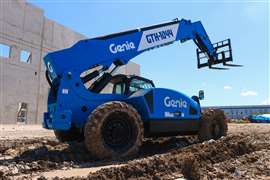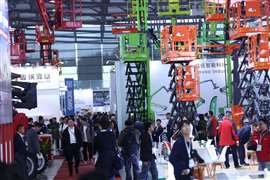Read this article in Français Deutsch Italiano Português Español
What is the Genie business worth and what type of buyer could it attract?
31 October 2025
 Genie’s GTH-1044
Genie’s GTH-1044
Terex has announced that it will sell or spin off its Genie aerials business, as it moves further into the waste processing and utility vehicles market amid a merger with REV Group.
The formal process to exit aerials started on 30 October, at the same time as Terex unveiled its Q3 financial highlights. Overall revenue climbed to US$1.4 billion, up from $1.2 billion in the same period a year before.
But sales in Terex’s aerials division dropped 13.2% year on year to US$537 million, amid lower volumes, unfavourable customer mix, and tariff headwinds. Operating margin also declined to 9.2% from 10.5% in the same period a year before.
It’s the ebb and flow of the aerial platforms business and the wider construction market that Terex’s CEO Simon Meester said the company wanted to move away from, as he hailed the tie-up with REV Group.
In a call with investors, he said that “exiting the aerials segment will take our performance to another level” with the promise of “resilient and predictable operating results”.
But he was also quick to emphasise that Genie remains a strong brand, with 60 years of history and a level playing field in North America and Europe thanks to recent anti-dumping measures that seek to limit the ability of Chinese manufacturers to undercut the prices of their western rivals.
“With this merger, we wanted to re-baseline the company. So with REV Group and our materials processing (MP) and Environmental Services Group (ESG) segment, we are becoming a new team. We want to pursue a much more predictable, less cyclical earnings profile,” he said.
Analysts on the call questioned the timing of Terex’s decision to sell Genie, given that the AWP market is currently at a low. But Meester said there were “plenty of suitors” for Genie. He added, “We believe aerials is a proven, strong business. There is a lot of upside coming from the megaprojects in the US alone and we see now that Europe is starting to invest in infrastructure and public construction, which will fuel further demand. We think there is a lot of upside for the aerial business for years to come.”
Valuation
However, Meester was not prepared to be drawn on what sort of price he expected Genie to fetch, arguing that it was premature to do so.
Back-of-the envelope calculations suggest that it could be worth somewhere in the range of $1.1 billion - $2.2 billion, based on a 5x to 10x multiple of Genie’s average annual operating profit over the past decade.
Meester instead described the business as a “very attractive asset”.
“It is a very strong business with a strong brand. There is no immediate risk for any kind of dumping activities in North America and Europe, so [there is] an attractive end market,” he added.
What sort of buyer could Genie attract?
When it comes to the type of buyer that Genie could attract, there are three general possibilities:
1) A Chinese OEM: Genie’s roots in North America (it was founded in 1966 in Seattle, Washington) could make it attractive to a Chinese manufacturer. Chinese OEMs have recently been buffeted not only by tougher conditions in their home market but a hokey-cokey of tariff announcements from the Trump administration, as well as a series of anti-dumping measures announced in both Europe and North America that Meester referenced.
Ownership of a US-based firm with a 60-year history could prove attractive to a Chinese owner that wanted to access North American and European markets. Those with a long memory will also remember that in 2016 Zoomlion made an out-of-the blue offer to acquire all of Terex for US$3.3 billion. Meester himself gave no indication as to whether a Chinese buyer could be interested in Genie. But he did note to investors that Genie “has a pretty strong US base”. And he added, “I see it as a very interesting asset that could give any owner a meaningful footprint in an attractive end market.”
As much as Genie would be a valuable strategic add-on for any number of Chinese OEMs, the fact remains that these companies have not been active acquirers outside China since the rush of deals in 2008-2012 (Zoomlion-Cifa, Sany-Putzmeister, XCMG-Schwing, LiuGong-Dressta).
2) An international OEM: Meanwhile, Genie is also likely to prove an attractive target for other established international OEMs. In some ways, the reasons are similar to those likely to appeal to Chinese firms: Genie offers instant brand recognition, as well as access to a well-developed global dealer and service network, especially in North America and Europe. Its aerial work platforms are also a cornerstone of rental fleets worldwide, allowing the would-be buyer to use these relationships to strengthen supply agreements or expand its own rental presence.
And then there’s the consideration that in buying Genie, a global OEM could prevent a Chinese manufacturer from gaining a foothold in mature western markets. However, over the years the AWP and telehandler business has proven itself to be one which works best as a speciality business, such as Genie within Terex, JLG within Oshkosh, or as a stand-alone like Manitou. Long-line manufacturers which have tried to enter the sector have generally failed, with only JCB – one of the original pioneers of the telehandler – being unique as a long-line manufacturer which is also strong in the aerial segment. An industry buyer would also inevitably have headaches around brand strategy and conflicts between its existing and acquired distribution network to work out.
3) A private equity firm: With the AWP sector likely bottoming out, Genie could also prove attractive to a private equity firm looking to take advantage of a possible upswing. Private equity firms typically look to exit after five to seven years, over which time, Genie could have enjoyed several years of growth.
There also remains the possibility of a spin-off of the business as an independent entity, although Meester’s assertion that there will be no shortage of suitors for Genie suggests that this is a less likely option.
 Genie’s GS scissor range
Genie’s GS scissor range
A spin-off would not raise cash for Terex and is only likely to happen if no buyer comes forward or bidders fail to offer an acceptable price.
In any event, Terex indicated to investors that the sale process is not starting from “ground zero”. While Meester gave away little, it appears that Terex has already been in conversation with possible buyers, although no formal process had been launched until Terex’s announcement of its merger with REV Group.
STAY CONNECTED



Receive the information you need when you need it through our world-leading magazines, newsletters and daily briefings.
CONNECT WITH THE TEAM












